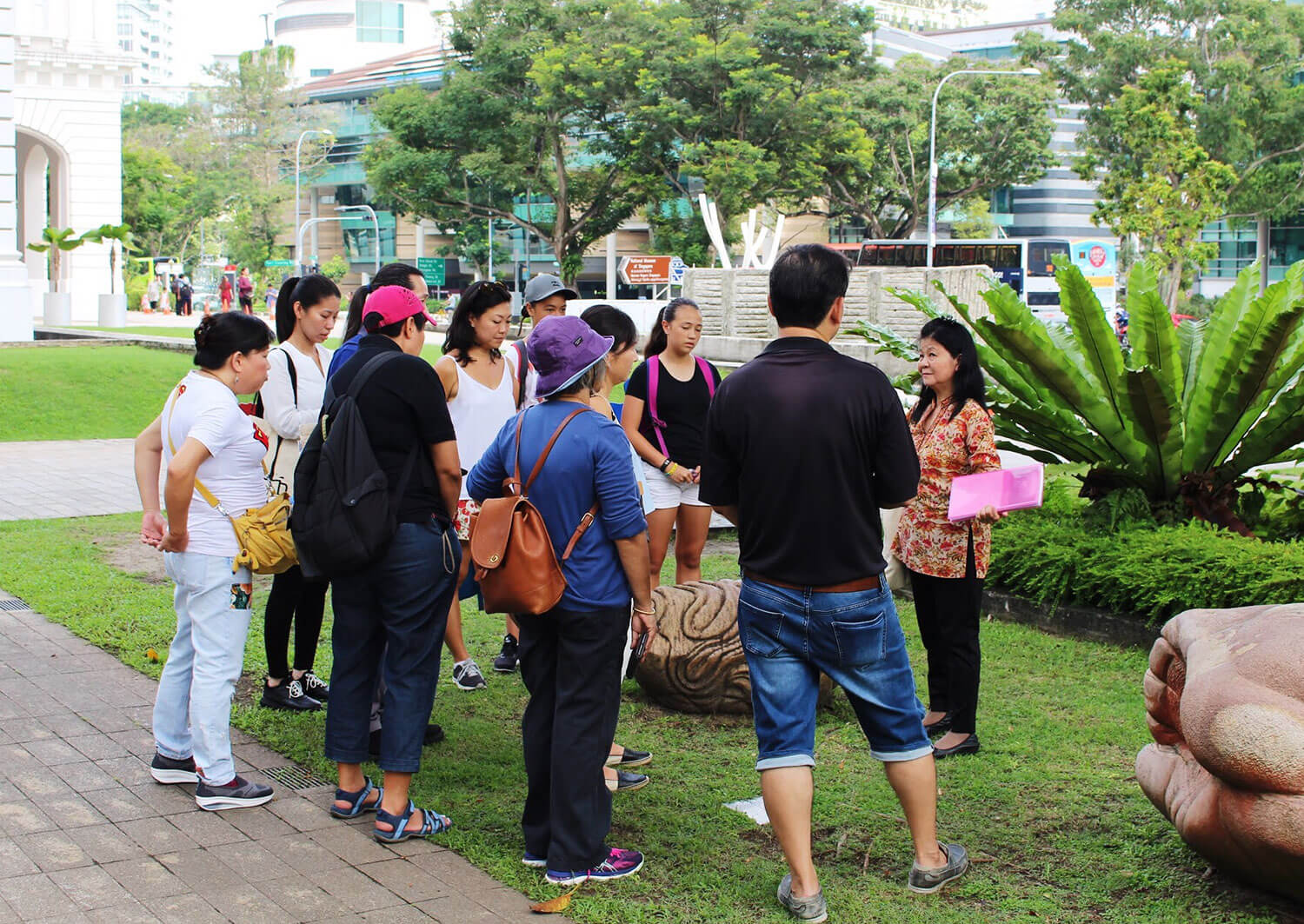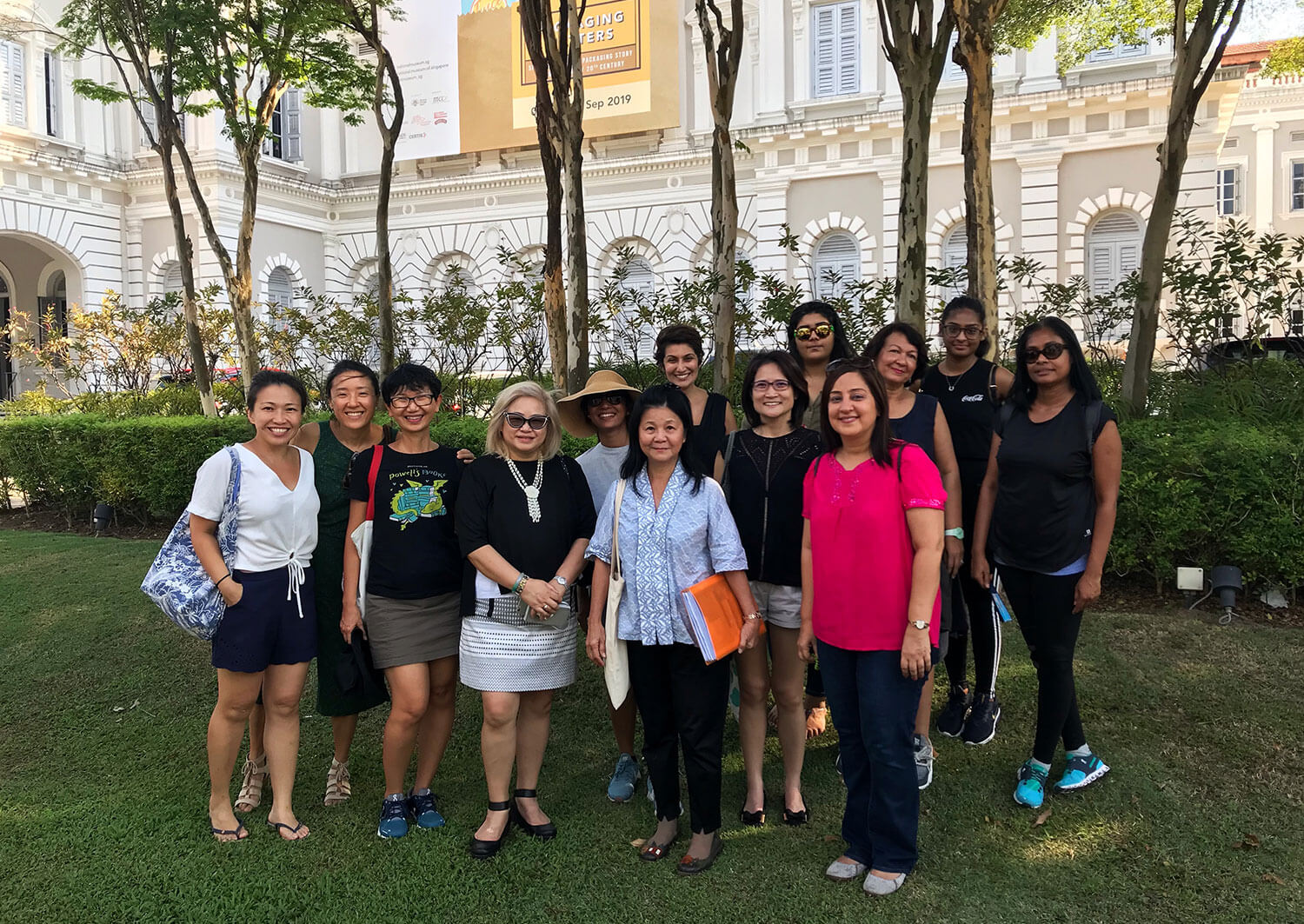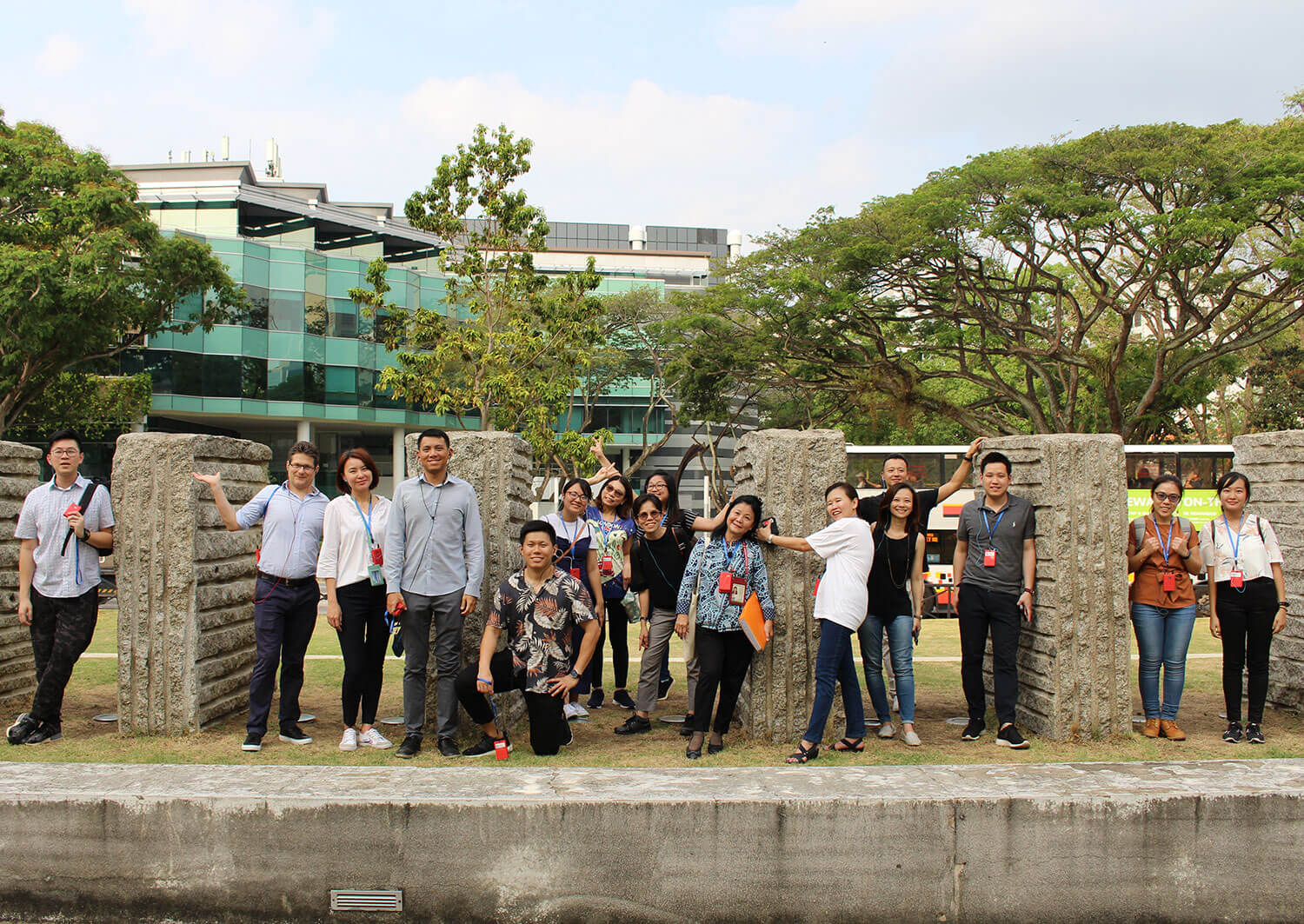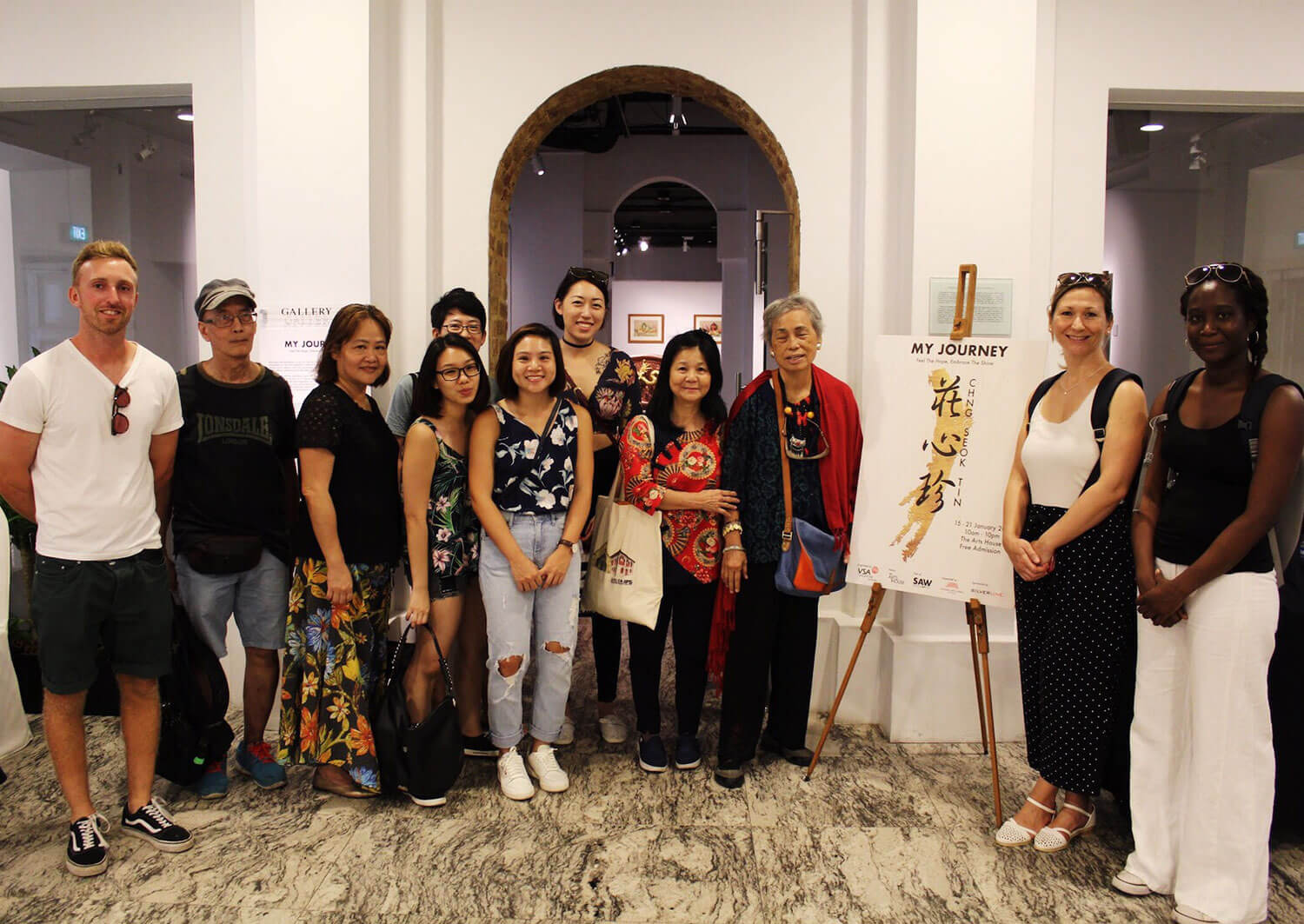Join Us on Our Heritage Walks
Immerse yourself in Singapore’s heritage and the impact that women have had on the nation’s development. These walks in and around the city centre take you by the buildings and areas associated with some of the women in the Singapore Women’s Hall of Fame. Expert guides offer fascinating information about the women, their achievements and their legacy.
The walks, which are titled “Walking in the Footsteps of our Foremothers”, each take about two hours around the Bras Basah Bugis Precinct.
Participants learn about:
- The rich history of each landmark along the route;
- How the women highlighted had a hand in the shaping of Singapore’s history
Learn more below about the locations of the key buildings featured in the walks and some information about how they are linked to women in the Hall of Fame.
For organised group tours, a minimum number of 10 pax is required, up to a maximum of 25 pax. Please contact us at swhf@scwo.org.sg or 6837 0611 for more information.
Walking in the Footsteps of our Foremothers
Our Heritage Walks take you around the civic and cultural centre of the city for a look at the buildings and areas associated with some of the women in the Singapore Women’s Hall of Fame.
The key buildings featured on these walks are indicated on this map, and you may click on the location pins for a brief description.
Do join us on our Heritage Walks for the complete historical walkthrough!
Site Information
1 - SCWO Building
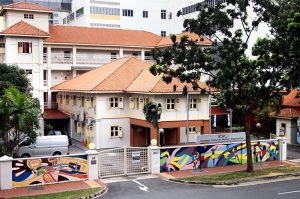 Waterloo Street is one of the oldest streets in Singapore. Known initially as Church Street, after Resident Councillor Thomas Church, it was renamed in 1858 to commemorate Britain’s victory over the French at the 1815 Battle of Waterloo.
Waterloo Street is one of the oldest streets in Singapore. Known initially as Church Street, after Resident Councillor Thomas Church, it was renamed in 1858 to commemorate Britain’s victory over the French at the 1815 Battle of Waterloo.
The street is lined with religious buildings, a reflection of the many communities that have long shared this space. The Sri Krishna Temple was built by the Hindus in 1870, the same year that a Methodist church opened its door at the junction of Waterloo Street and Middle Road.
In 1878, the Jewish community built the Maghaim Aboth Synagogue, and in 1884 the Chinese community opened the Kwan Im Thong Hood Cho Temple.
Many of the large houses along Waterloo Street, including the one that now houses the SCWO, were built and lived in by Jewish families.
At one point there were as many as 72 families living in the subdivided rooms of what is now the SCWO Centre.
SCWO today
The Singapore Council of Women’s Organisations (SCWO) is the umbrella body of women’s organisations in Singapore. Our 60 member organisations represent more than 600,000 women in Singapore.
Incorporated in March 1980, the SCWO seeks to promote the ideals of ‘Equal Space, Equal Voice and Equal Worth’ for women in Singapore.
In 2014 the SCWO launched the Singapore Women’s Hall of Fame (SWHF) which recognises and honours Singapore’s most outstanding women.
The SWHF includes women’s rights activists such as:
Shirin Fozdar, who was the driving force of the Singapore Council of Women (SCW) that was formed in 1952 to look into women’s issues and to campaign for a ban on polygamy. This ban, and other measures to protect women and children, came about in 1961 when the Women’s Charter became law.
Anamah Tan, a lawyer specialising in family law and a women’s rights activist. In 1974 she was a founder member of the Singapore Association of Women Lawyers (SAWL), and in 1980 she helped to form the SCWO.
2 - OBJECTIFS (Former Methodist Girls School)
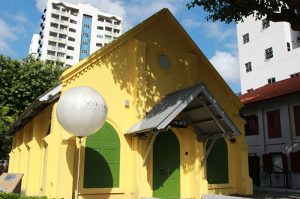 At 155 Middle Road is a historic, 19th century church building that many know as the Middle Road Church. It is one of the few remaining examples of gothic architecture in Singapore. With its rich history spanning 130 years, it was designated a historic site by the National Heritage Board in 2000.
At 155 Middle Road is a historic, 19th century church building that many know as the Middle Road Church. It is one of the few remaining examples of gothic architecture in Singapore. With its rich history spanning 130 years, it was designated a historic site by the National Heritage Board in 2000.
The building has served various purposes and communities at various points. Built between 1870 and 1875, it was first known as the Christian Institute and served as a space for young men to worship. Later on, it housed both Methodist Girls’ School and a group of Straits Chinese.
In 1894, it became the first Straits Chinese Methodist Church in Singapore. By 1929 the congregation had become so large that the church moved to Kampong Kapor, where it is known as the Kampong Kapor Methodist Church. During the Japanese Occupation, the building housed the May Blossom Restaurant and in the 1980s, it was briefly a car workshop.
The building is now occupied by Objectifs, a non-profit visual arts centre dedicated to photography and film in Singapore. Formed in 2003, Objectifs holds workshops, exhibitions, and screenings to cultivate interest in the local visual arts.
Sophia Blackmore, an Australian missionary who founded Methodist Girls School in 1887, is one woman associated with the building. The school was, for a short time, housed there.
3 - Nanyang Academy of Fine Arts (NAFA)
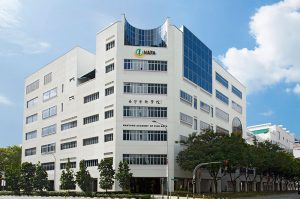
Photo courtesy of Nanyang Academy of Fine Arts
The Nanyang Academy of Fine Arts (NAFA) was officially opened in 1938, a few years after Japan-trained Chinese artist Huang Suiheng visited Singapore in the 1930s. Suiheng, sensing the artistic potential of the trading port’s east-meets-west heritage, encouraged instructor Lim Hak Tai to set up an Arts School there.
Together with a few other arts education advocates, Hak Tai migrated to Singapore in 1937 and launched the academy in an old two-storey shophouse at 167 Geylang, with 14 students in the first intake.
As the popularity of the school grew, the school had to relocate several times to accommodate the increasing number of students. In 2004, NAFA succeeded in securing three plots of land along Bencoolen Street and constructed its own purpose-built campus. This was the first time in the academy’s history that it had its own building.
NAFA has since its founding, had a diverse student population. The tradition of taking in international students continues today, with many of the academy’s alumni going on to make an impact in a variety of fields.
To date, the arts school has produced 13 recipients of the Cultural Medallion, Singapore’s most prestigious arts and culture accolade, and 14 Young Artist Award winners.
Its outstanding staff included at one point SWHF honourees Georgette Chen, an internationally renowned trailblazer of the visual arts, and Chng Seok Tin, one of Singapore’s most versatile artists and an advocate for disabled artists.
4 - National Library of Singapore
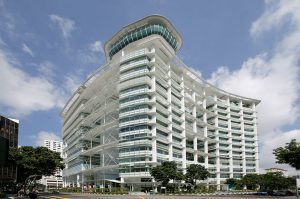
Photo courtesy of National Library Board, Singapore, All Rights Reserved, 2016
The National Library was established by Sir Stamford Raffles in 1823 to support Singapore’s first major educational institution, the Singapore Institution, today known as the Raffles Institution. After World War II, it began to service the reading and reference needs of the wider population.
On 31 March 2004, the iconic red-bricked National Library at Stamford Road closed its doors after nearly 50 years of service. A year-long series of events marked the closing of one chapter and the start of a new one.Today, all that remains of the building at its original site are two red-bricked entrance pillars standing near the Fort Canning Tunnel.
At the library’s new home on Victoria Street, some 5, 000 of the red bricks of the old building were incorporated into various elements. Some were used to construct a commemorative wall in the bamboo garden on the basement floor. Another remnant of the old building is a geometric floor-pattern consisting of four adjoining crosses. Known as the St Andrew’s Cross, it was relocated from the foyer of the old building to the plaza of the new building.
A woman who played an instrumental role in expanding and modernising the National Library is Hedwig Anuar, the first Singaporean to be Director of the National Library. During her term, the library network expanded from a single library to nine libraries spread around Singapore.
5 - Raffles Hotel
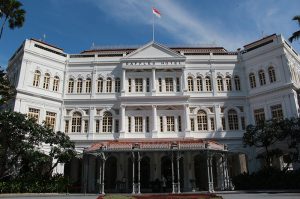 Built in the early 1830s, Raffles Hotel started out as a privately owned beach house.
Built in the early 1830s, Raffles Hotel started out as a privately owned beach house.
It acquired its famed name only in 1887 when Armenian hoteliers Sarkies Brothers leased the property and transformed it into a high-end hotel.
The five star hotel is known around the world and is a must-see for many tourists. Its classic colonial architecture stands in sharp contrast to the towering modern buildings that surround it. In 1987, on its 100th year anniversary, the Raffles Hotel was declared a National Monument by the Singapore government.
The hotel was managed at one point by Jennie Chua, who is regarded as an icon of Singapore’s hospitality industry.
6 - Old RGS gate (outside SMU LKC School of business)
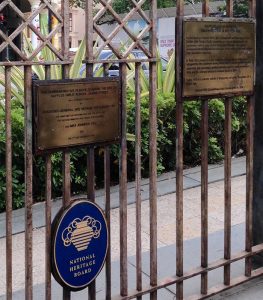 Raffles Institution, the oldest school in Singapore, only admitted boys when it was founded in 1823.
Raffles Institution, the oldest school in Singapore, only admitted boys when it was founded in 1823.
In 1844, it began to admit girls. In 1879, Raffles Girls’ School (RGS) was established as a separate wing of the school. Female students joined their male counterparts in their 5th year for their pre-university education leading to the GCE A-Levels.
In 1959 RGS split into primary and secondary schools. The secondary school moved to Anderson Road, while the primary section first remained in Queen Street, before settling at its present campus at Hillcrest Road in 1999.
Though the old school buildings are long gone, the gate was preserved and until 2016 stood outside one of the buildings of the Singapore Management University. This has been replaced with a plaque.
One Rafflesian who made her mark is Maggie Lim. One of the few girls in the male-dominated Raffles Institution, Maggie won the Queen’s Scholarship in 1930, making her the first female in the award’s 45-year history and the second Singaporean to win it.
Another was Stella Kon, author of internationally-staged, award-winning play, Emily of Emerald Hill.
Cheong Koon Hean, the key architect of Singapore’s cityscape and housing estates, made history in 2004 when she became the first woman to head the Urban Redevelopment Authority.
Other notable alumnae of Raffles Girls School include Tang Pui Wah, Lim Hwee Hua, Lee Choo Neo, Leaena Tambyah, Jane Lee, Jackie Yi Ru-Ying, Anne Lee Tzu Pheng, Margaret Leng Tan, and Mrs Seow Peck Leng.
7 - CHIJMES (Former CHIJ Town Convent)
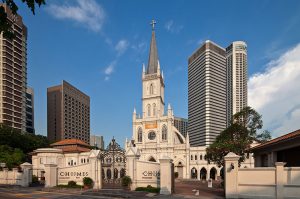
Photo Courtesy of Preservation of Sites and Monuments Division, National Heritage Board
Bordered by Bras Basah Road, Stamford Road, Victoria St and North Bridge Road, the complex of convent buildings that today is CHIJMES, was a Catholic convent and school for 132 years.
In 1854, four Sisters of the Holy Infant Jesus, led by Reverend Mother Mathilde Raclot, came to Singapore from Penang. Within 10 days of their arrival they had opened the first CHIJ School. The Sisters took in orphans, did needlework to support themselves and taught fourteen children. Secondary education began in 1905.
After World War II, the school moved to new premises. The land on which the original school stood was acquired by the government and the chapel was deconsecrated in the 1980s. A part of the Sisters’ quarters was demolished to make way for the offices of the SMRT Corporation. But most of the buildings were preserved by The Heritage Board and redeveloped as CHIJMES, a multi-purpose food and entertainment compound popular with tourists.
CHIJ has since split into CHIJ Secondary and CHIJ Primary, with both schools located in Toa Payoh. The CHIJ family of schools in Singapore now comprises 11 primary and secondary schools, and 2 children’s homes, with a total student population of close to 16,000 and a huge alumnus.
Notable CHIJ alumni include Chan Heng Chee, Joanna Wong Quee Heng, Noeleen Heyzer, Jennifer Lee Gek Choo, Gloria Lim, Elizabeth Choy, Catherine Lim, Suchen Christine Lim, and Junie Sng Poh Leng.
8 - SMRT Corporation
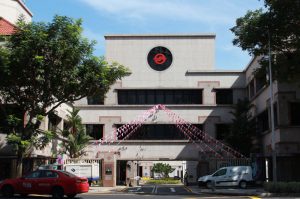 The area where the SMRT Corporation Headquarters now stands used to be part of the CHIJ convent complex.
The area where the SMRT Corporation Headquarters now stands used to be part of the CHIJ convent complex.
SMRT was incorporated on March 6, 2000, following an industry overhaul to form multi-modal public-transport operators in Singapore.
One woman heavily involved in the launch of Singapore’s Mass Rapid Transit System, even before SMRT was established, was Lim Soo Hoon.
Soo Hoon has held many high-profile positions in her public service career spanning more than 30 years. In 1999, she made history when she was appointed Permanent Secretary at the then Ministry of Community Development (MCD).
This was the first time a woman had become a Permanent Secretary in Singapore. Soo Hoon has been involved in the development and implementation of many key policies and projects. Among these are the launch of Singapore’s Mass Rapid Transit System and the introduction of the Singapore Sports School.
9 - Supreme Court
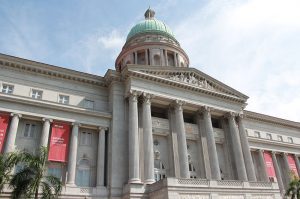 The Old Supreme Court Building was built between 1937 and 1939.Designed by Frank Dorrington Ward, then the chief architect of the Straits Settlements Public Works Department, it is the last building in Singapore to be built in the classic architectural style.
The Old Supreme Court Building was built between 1937 and 1939.Designed by Frank Dorrington Ward, then the chief architect of the Straits Settlements Public Works Department, it is the last building in Singapore to be built in the classic architectural style.
It features Corinthian columns and lofty interiors with murals by Italian artists. Ward was responsible for many of Singapore’s landmarks. The old courthouse was his final and most significant piece of work.
The original building had four courts. Another seven were added over the years as the caseload grew. In the 1980s, more courtrooms were constructed in the neighbouring City Hall Building.
In 1929, when the legal landscape was dominated by men, Teo Soon Kim became the first woman admitted to the bar in the Straits Settlements.
In 1966, Jenny Lau Buong Bee further made Singapore legal history when she became the first woman to be appointed a district judge.
More recently, in 1991, a glass ceiling in the Singapore Judiciary was shattered when Lai Siu Chiu was appointed Judicial Commissioner. She again broke tradition three years later by becoming the first female Supreme Court Judge.
In 2006, the Supreme Court moved to a custom-built complex just behind the original building. Today, the former Supreme Court building is part of the National Gallery of Singapore. The gallery is home not just to an extensive collection of art but also the National Kitchen, the latest venture by Singapore’s food ambassador, Violet Oon.
10 - Victoria Theatre & Concert Hall
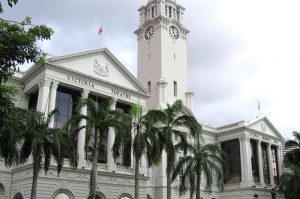
Photo By User:Sengkang (Own work) [Copyrighted free use], via Wikimedia Commons
Adjacent to the theatre is the Concert Hall, formerly known as the Victoria Memorial hall in honour of Queen Victoria who passed away in 1901. It was built between 1903 and 1905 using public funds raised by the colonial government. In the same year, a 54m clock tower was erected to join the two buildings.
In 1942 the memorial hall served as a hospital shortly before the fall of Singapore. It was also there that war crime trials were held following Japan’s surrender.
In the years leading to independence, the halls were used for public meetings such as a review the Constitution of the Colony of Singapore, and later for the inaugural meeting of the People’s Action Party. Singapore’s pilot television broadcasting service, Television Singapura, was launched there on 15 February 1963.
After several rounds of extensive renovations, the Victoria Memorial Hall was renamed Victoria Concert Hall in 1980. It became home to the newly formed Singapore Symphony Orchestra (SSO), of which acclaimed violinist and 2006 Cultural Medallion recipient Lynnette Seah is a founding member.
The SSO is a full-time professional orchestra that has gained worldwide recognition. Lynette serves as its co-concertmaster and the leader of the 1st violin section.
The Victoria Theatre and Concert Hall was gazetted as national monument in 1992. From 2010 to 2014, it underwent another major facelift that cost $158 million. It was reopened on 15 July 2014 with a performance by the SSO to celebrate the occasion.

Photo By User:Sengkang (Own work) [Copyrighted free use], via Wikimedia Commons
11 - Parliament House
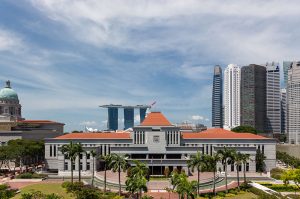
Photo courtesy of The Parliament of Singapore
The new Parliament House was officially opened in 1999. Space constraints had been an issue at the former Parliament House from the early 1980s.
The new building was designed to incorporate elements of the old and new. The slate grey colour scheme and columned corridors is a contemporary interpretation of stateliness, while the prism-shaped top was former President Ong Teng Cheong’s modernist interpretation of the traditional dome.
The original building, which is now known as the Arts House, was home to Singapore’s Parliament from 1965 to 1999, and to the Legislative Assembly from 1955 to 1965.
In 1949, Phyllis Eu Cheng Li became one of the first women elected to public office in Singapore when she won a seat on the Municipal Commission. In a life dedicated to education and public service, she also fought for consumers’ rights and worked to involve women in politics.
More recently, in 2001, Halimah Yacob became the first Malay woman to be elected an MP. In 2013, she became the first female Speaker of Singapore.
12 - MCCY/MICA Building (Old Hill Street Police Station)
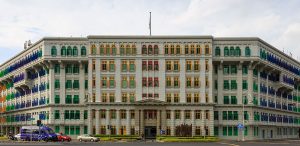
Photo by CEphoto, Uwe Aranas
The Old Hill Street Police Station was a six-storey neo-Classical building located at the junction of Hill Street and River Valley Road. It cost $494,000 to construct in 1934 — a hefty sum back then — and was the largest police barracks in British Malaya.
The spacious compound also housed a parade ground, quarters for the staff and their families, playgrounds for the children of the European police officers, and also Singapore’s first jail.
During World War II, the Hill Street Police Station, like the Central Police Station, was commandeered by the Japanese.
The building was gazetted as a national monument in 1998. It is used today by the Ministry of Communications and Information (MCI) and Ministry of Culture, Community and Youth, including the National Arts Council, the National Heritage Board and the Media Development Authority.
Recruitment of women to the Singapore police force started only in the 1950. One of 10 women who responded to the initial call, Mary Quintal rapidly rose through the ranks to become, in 1961, the first woman assistant superintendent of police.
13 - Armenian Church
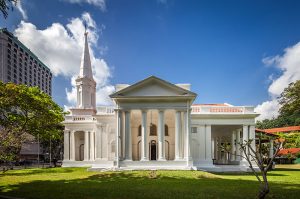
Photo courtesy of Preservation of Sites and Monuments Division, National Heritage Board
Armenian Street is a shortened version of the road’s original name, Armenian Church Street.
It was named for the Armenian Apostolic Church of Saint Gregory, which was constructed in 1836, and is the oldest church in Singapore.
Agnes Joaquim was a regular volunteer there. A skilled horticulturalist, she was the first woman in the world to breed a hybrid orchid. Her orchid won the prize for the rarest orchid at the 1899 annual flower show. The Vanda Miss Joaquim, named after her, was chosen in 1981 as Singapore’s national flower because of its resilience and year round blooming quality.
14 - YWCA Fort Canning Lodge
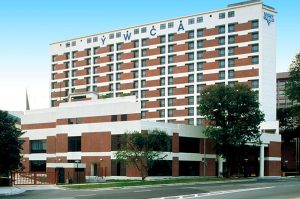
Photo Courtesy of Fort Canning Lodge
The Young Women’s Christian Association was founded in 1875 by British missionary Sophia Cooke to provide education and a support group for women and girls.
Over the years, the YWCA has consistently dedicated their work to not only help women and children but also the community as a whole regardless of race and religion. It created opportunities and organized programmes for social interaction, self- enrichment in addition to providing social aid through financial assistance, hostel for girls, and childcare centres.
YWCA also provided accommodation for women, which started in 1906. In 1914, YWCA secured the land and property at No. 8 Fort Canning Road and operated a hostel for women. Today, it is the site of Fort Canning Lodge, which offers accommodation for travellers.
Past Presidents of YWCA included Mrs Julie Tan Eng Poh, founder of the first and only credit union for women in Singapore, and Mrs Checha Davies, a prominent women’s rights activist who ensured the completion of many of the association’s key projects.
15 - SMU Law School
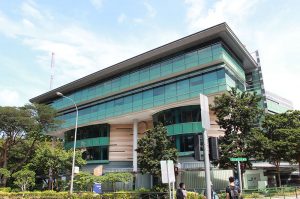 The Singapore Management University (SMU) School of Law is one of the six schools of Singapore Management University.
The Singapore Management University (SMU) School of Law is one of the six schools of Singapore Management University.
The school was established in 2007, half a decade after Singapore’s first law school opened its doors at the National University of Singapore.
The SMU School of Law has a business-centric legal curriculum, aiming to prepare its graduates for law practice both locally and regionally.
Its advisory board includes Lee Suet Fern, founder of Stamford Law Corporation. Suet Fern has been involved in many of Singapore’s most significant corporate transactions and has been named a leading practitioner in numerous professional publications.
One of Singapore’s most well-known female lawyers is Kwa Gek Choo, co-founder of one of Singapore’s largest law firms Lee and Lee. She was a highly skilled legal draftsman who drafted crucial provisions in the Separation Agreement between Singapore and Malaysia. Her crucial provisions guaranteed Singapore’s continued water supply when Singapore separated from Malaysia, an agreement that still holds in present day Singapore.
16 - National Museum of Singapore
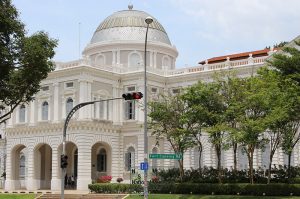 The National Museum of Singapore is the oldest of the country’s four national museums. First established as the Raffles Library and Museum, it was set up in 1849 as part of the library of the Singapore Institution, later renamed the Raffles Institution.
The National Museum of Singapore is the oldest of the country’s four national museums. First established as the Raffles Library and Museum, it was set up in 1849 as part of the library of the Singapore Institution, later renamed the Raffles Institution.
After several moves to the Town Hall (now known as the Victoria Theatre and Concert Hall), and back to a new wing of the Singapore Institution, the Raffles Library and Museum finally settled in a new building at Stamford Road. The museum officially opened its doors in 1887.
Following Singapore’s independence in 1965, the museum focused on showcasing Singapore’s history and nation building efforts. The building was gazetted as a national monument in 1992.
It houses two sculptures commissioned from 1995 Cultural Medallion recipient Han Sai Por. A prolific sculptor, she has held numerous solo and group exhibitions. Some of her more than 20 public sculptures are on display as far afield as the Portland Sculpture Park in England, the US, Malaysia, Japan and China. 20 Tonnes (2002) stands right at the front of the museum.
This imposing structure was sculpted from a single piece of granite. Her other structure, Seeds (2006) was formed with rocks from the nearby Fort Canning Hill.
17 - YMCA
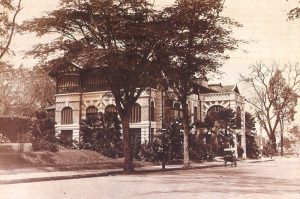
Photo courtesy of YMCA of Singapore
The Young Men’s Christian Association (YMCA) of Singapore was established in 1902 by Robert Pringle, who also started YMCA in Bombay (India) and Colombo (Sri Lanka).
The YMCA’s priority was to provide its members with self-enrichment programmes and sports activities. Technical education classes were launched in 1913, followed by business education courses in 1919.
The YMCA also equipped youths with sports facilities to keep them away from unsavoury activities like gambling, which was rampant then.
During World War II, the YMCA was transformed into an internment centre for British administrators and staff. It also served as the Japanese Kempeitai, or secret military police’s, interrogation and torture headquarters.
It was there that war heroine Elizabeth Choy was imprisoned and tortured for 193 days for smuggling food, medicine, money, letters and radios to British prisoners-of-war. In recognition of her valour during the Japanese Occupation, she was awarded the Order of the British Empire in 1946. Elizabeth would later on go on to participate in politics, making history by becoming the first and only woman member of the Legislative Council, the highest decision-making body in Singapore at that time.
After the war, the British moved to convert the land where YMCA stood into a memorial for those who had suffered under the Japanese Occupation. It was after numerous discussions that YMCA was able to reclaim the site and resume its operations.
Since then, the YMCA has established itself as a leading Voluntary Welfare Organisation (VWO) that reaches out to many of the needy, both in Singapore and overseas. In the 1980s, YMCA pioneered the first Social Service Centre in Singapore (currently known as the Ang Mo Kio Family Service Centre). It was set up in response to government initiative to build a healthier community through supporting individuals and families by providing developmental, preventive and remedial services. The centre was a partnership with the Anglican Church and Asian Women Welfare Association. By 1985, the centre became an autonomous entity but the YMCA continued to support the centre’s projects.
18 - St. Andrews Medical Dispensary
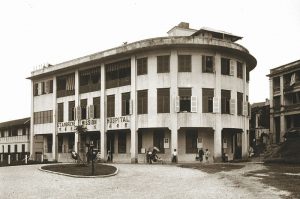
Photo Courtesy of St. Andrew’s Mission Hospital
The St. Andrew’s Medical Mission at Bencoolen Street was founded in 1913 by Charlotte E. Ferguson-Davie, a medical doctor and missionary who worked in India before arriving in Malaya.
The dispensary catered specially to women and children, as Charlotte observed that Asian women were uncomfortable with seeking treatment from male doctors. For those who could not afford to pay, the services were provided free of charge.
The clinic was so well received that, four months later, a second dispensary was set up at Upper Cross Street. It was later relocated to North Bridge Road in 1917. A third branch at Pasir Panjang was opened in 1915 to serve the Malay Community, but closed shortly later in 1919.
In 1916, the mission pioneered a programme to train women of various nationalities in general nursing and midwifery. The programme grew into a full-fledged three year course by 1922.
In 1923, the mission acquired funds from philanthropists like Mr and Mrs Lee Choon Guan as well as organisations like the St. Andrew’s Cathedral to build a three storey hospital at Erskine Road – the St. Andrew’s Mission Hospital (SAMH). From there, the hospital developed specialist clinics such as an eye clinic for abandoned blind children, and a venereal disease clinic for women.
In 1954 SAMH appointed Janet Lim as its matron. She was the first local woman to be a hospital matron. In 1958 her best-selling book Sold for Silver, an account of her years as a bonds maid, was published. It was the first local autobiography and first book in English by a Singapore woman.

